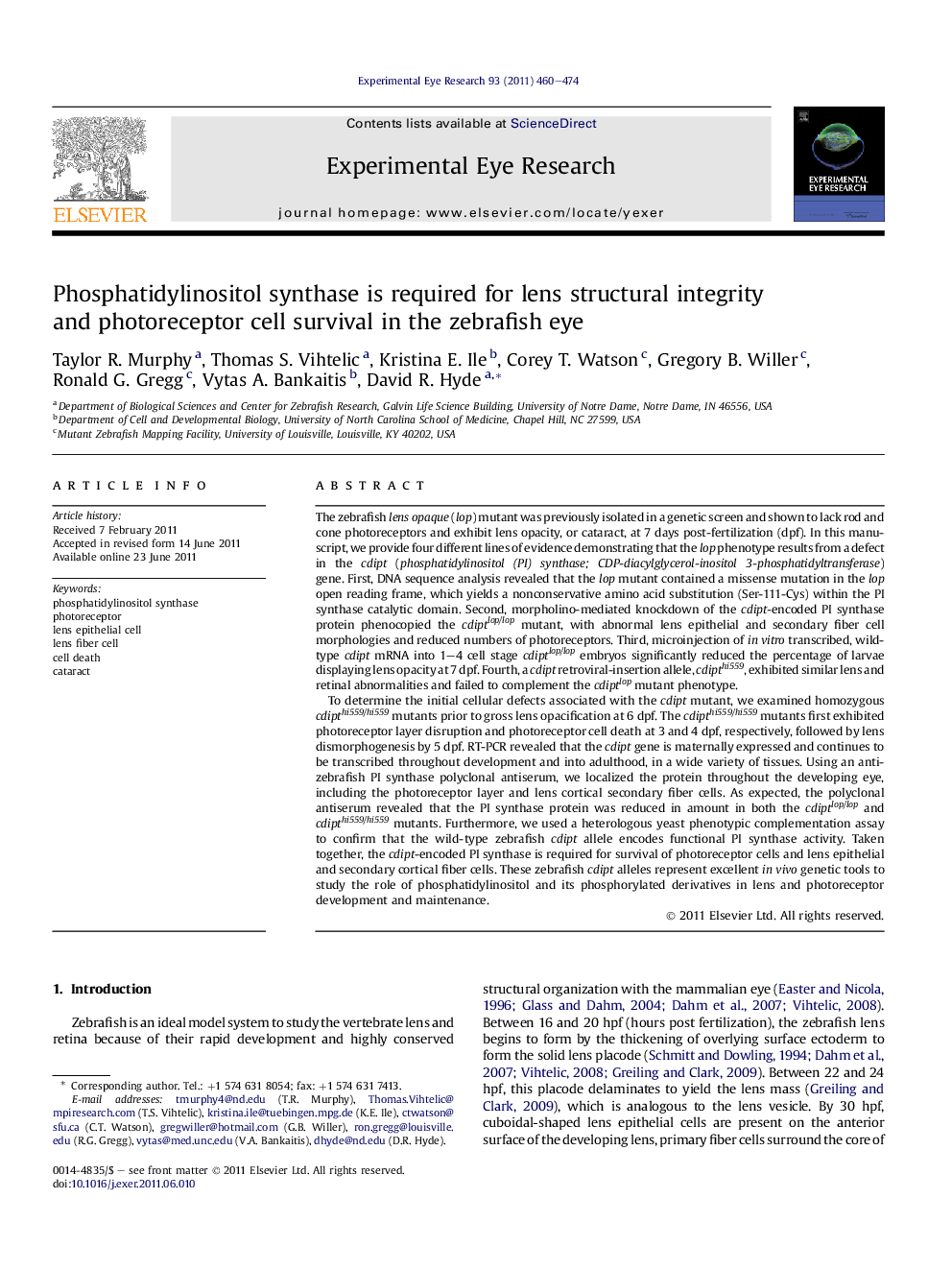| کد مقاله | کد نشریه | سال انتشار | مقاله انگلیسی | نسخه تمام متن |
|---|---|---|---|---|
| 4011588 | 1261153 | 2011 | 15 صفحه PDF | دانلود رایگان |

The zebrafish lens opaque (lop) mutant was previously isolated in a genetic screen and shown to lack rod and cone photoreceptors and exhibit lens opacity, or cataract, at 7 days post-fertilization (dpf). In this manuscript, we provide four different lines of evidence demonstrating that the lop phenotype results from a defect in the cdipt (phosphatidylinositol (PI) synthase; CDP-diacylglycerol-inositol 3-phosphatidyltransferase) gene. First, DNA sequence analysis revealed that the lop mutant contained a missense mutation in the lop open reading frame, which yields a nonconservative amino acid substitution (Ser-111-Cys) within the PI synthase catalytic domain. Second, morpholino-mediated knockdown of the cdipt-encoded PI synthase protein phenocopied the cdiptlop/lop mutant, with abnormal lens epithelial and secondary fiber cell morphologies and reduced numbers of photoreceptors. Third, microinjection of in vitro transcribed, wild-type cdipt mRNA into 1–4 cell stage cdiptlop/lop embryos significantly reduced the percentage of larvae displaying lens opacity at 7 dpf. Fourth, a cdipt retroviral-insertion allele, cdipthi559, exhibited similar lens and retinal abnormalities and failed to complement the cdiptlop mutant phenotype.To determine the initial cellular defects associated with the cdipt mutant, we examined homozygous cdipthi559/hi559 mutants prior to gross lens opacification at 6 dpf. The cdipthi559/hi559 mutants first exhibited photoreceptor layer disruption and photoreceptor cell death at 3 and 4 dpf, respectively, followed by lens dismorphogenesis by 5 dpf. RT-PCR revealed that the cdipt gene is maternally expressed and continues to be transcribed throughout development and into adulthood, in a wide variety of tissues. Using an anti-zebrafish PI synthase polyclonal antiserum, we localized the protein throughout the developing eye, including the photoreceptor layer and lens cortical secondary fiber cells. As expected, the polyclonal antiserum revealed that the PI synthase protein was reduced in amount in both the cdiptlop/lop and cdipthi559/hi559 mutants. Furthermore, we used a heterologous yeast phenotypic complementation assay to confirm that the wild-type zebrafish cdipt allele encodes functional PI synthase activity. Taken together, the cdipt-encoded PI synthase is required for survival of photoreceptor cells and lens epithelial and secondary cortical fiber cells. These zebrafish cdipt alleles represent excellent in vivo genetic tools to study the role of phosphatidylinositol and its phosphorylated derivatives in lens and photoreceptor development and maintenance.
► The lens opaque mutation is a missense change in PI (phosphatidylinositol) synthase.
► PI synthase is required for photoreceptor cell viability.
► PI synthase is necessary to maintain lens epithelial cells.
► PI synthase is required for lens cortical secondary fiber differentiation.
Journal: Experimental Eye Research - Volume 93, Issue 4, October 2011, Pages 460–474